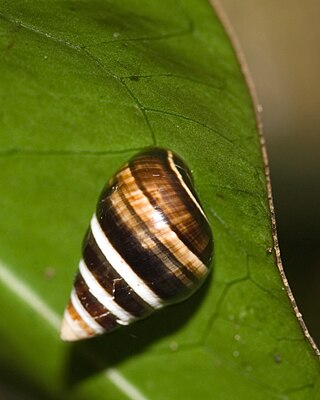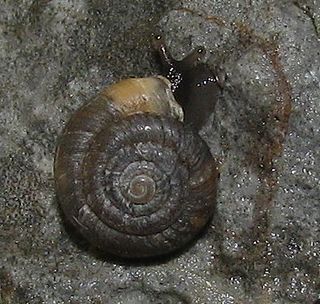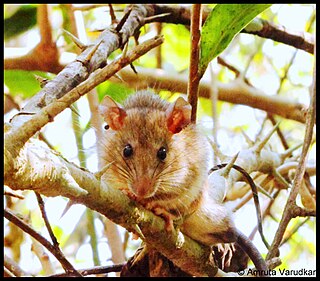
Pseudotsuga is a genus of evergreen coniferous trees in the family Pinaceae. Common names for species in the genus include Douglas fir, Douglas-fir, Douglas tree, Oregon pine and Bigcone spruce. Pseudotsuga menziesii is widespread in western North America and is an important source of timber. The number of species has long been debated, but two in western North America and two to four in eastern Asia are commonly acknowledged.

Pinus contorta, with the common names lodgepole pine and shore pine, and also known as twisted pine, and contorta pine, is a common tree in western North America. It is common near the ocean shore and in dry montane forests to the subalpine, but is rare in lowland rain forests. Like all pines, it is an evergreen conifer.

Pinus ponderosa, commonly known as the ponderosa pine, bull pine, blackjack pine, western yellow-pine, or filipinus pine is a very large pine tree species of variable habitat native to mountainous regions of western North America. It is the most widely distributed pine species in North America.

Temperate rainforests are rainforests with coniferous or broadleaf forests that occur in the temperate zone and receive heavy rain.

The marsh shrew, also known as the Pacific water shrew, Bendire's water shrew, Bendire's shrew and Jesus shrew is the largest North American member of the genus Sorex. Primarily covered in dark-brown fur, it is found near aquatic habitats along the Pacific coast from southern British Columbia to northern California. With air trapped in its fur for buoyancy, marsh shrews can run for three to five seconds on top of the water. It measures about 16 cm (6.3 in) in length, including a 7-centimetre (2.8 in)-long tail, and weighs an average of 14.5–16 g (0.51–0.56 oz). The marsh shrew's diet consists mainly of invertebrates, which it hunts on land and in the water. They are rare; their populations are thought to be in decline, and they are considered endangered in parts of their range.

The sockeye salmon, also called red salmon, kokanee salmon, blueback salmon, or simply sockeye, is an anadromous species of salmon found in the Northern Pacific Ocean and rivers discharging into it. This species is a Pacific salmon that is primarily red in hue during spawning. They can grow up to 84 cm in length and weigh 2.3 to 7 kg (5–15 lb). Juveniles remain in freshwater until they are ready to migrate to the ocean, over distances of up to 1,600 km (1,000 mi). Their diet consists primarily of zooplankton. Sockeye salmon are semelparous, dying after they spawn. Some populations, referred to as kokanee, do not migrate to the ocean and live their entire lives in fresh water.

The grove snail, brown-lipped snail or lemon snail is a species of air-breathing land snail, a terrestrial pulmonate gastropod mollusc.
The Trinity bristle snail is a species of medium-sized land snail, a terrestrial pulmonate gastropod mollusc in the family Monadeniidae.
An evolutionarily significant unit (ESU) is a population of organisms that is considered distinct for purposes of conservation. Delineating ESUs is important when considering conservation action. This term can apply to any species, subspecies, geographic race, or population. Often the term "species" is used rather than ESU, even when an ESU is more technically considered a subspecies or variety rather than a biological species proper. In marine animals the term "stock" is often used as well.

The weebill is a species of bird in the family Acanthizidae. It is an insectivorous passerine that is found throughout mainland Australia. At 8 to 9 cm long, it is Australia's smallest bird. It was originally described by John Gould in 1838, and four subspecies are recognised. The weebill's plumage is nondescript, with olive-grey upperparts and paler, more yellowish underparts. It grades from more brownish plumage in the southern regions of Australia to more yellow in tropical areas.

The Madeiran wall lizard is a species of lizard in the family Lacertidae. It is the only species in the genus Teira. The species is endemic to the Madeira Archipelago, Portugal. In the Azores, this lizard has become naturalized after involuntary introduction by the shipping trade between the two archipelagos. There are four recognized subspecies.

Achatinella mustelina is a species of air-breathing land snail, a terrestrial pulmonate gastropod mollusc in the family Achatinellidae. This species is endemic to the Waianae Range of the island of Oahu, Hawaii.

Monadenia is a genus of air-breathing land snails in the subfamily Monadeniinae.

Noricella oreinos is a species of small, air-breathing land snail, a terrestrial pulmonate gastropod mollusk in the family Hygromiidae, the hairy snails and their allies. This species is endemic to Austria.

There are 14 species of amphibians and 5 species of reptiles known to occur in Mount Rainier National Park.

Elymus caninus, the bearded couch or bearded wheatgrass, is a species of flowering plant in the family Poaceae that is native to Europe including the UK but can be found introduced in the US states of Oregon and Washington. E. caninus has been observed in two morphotypes; the first population being "pauciflorum," with the second being "caninus."

The Sahyadris forest rat is a species of rat belonging to the family Muridae. It is native to the northern Western Ghats in India where it is split between three regions, Satara in Maharashtra, the Nilgiri mountains in Tamil Nadu and Kodagu district in Karnataka.

The Pacific marten is a species of North American mammal, a member of the family Mustelidae. It is found throughout western North America.
















